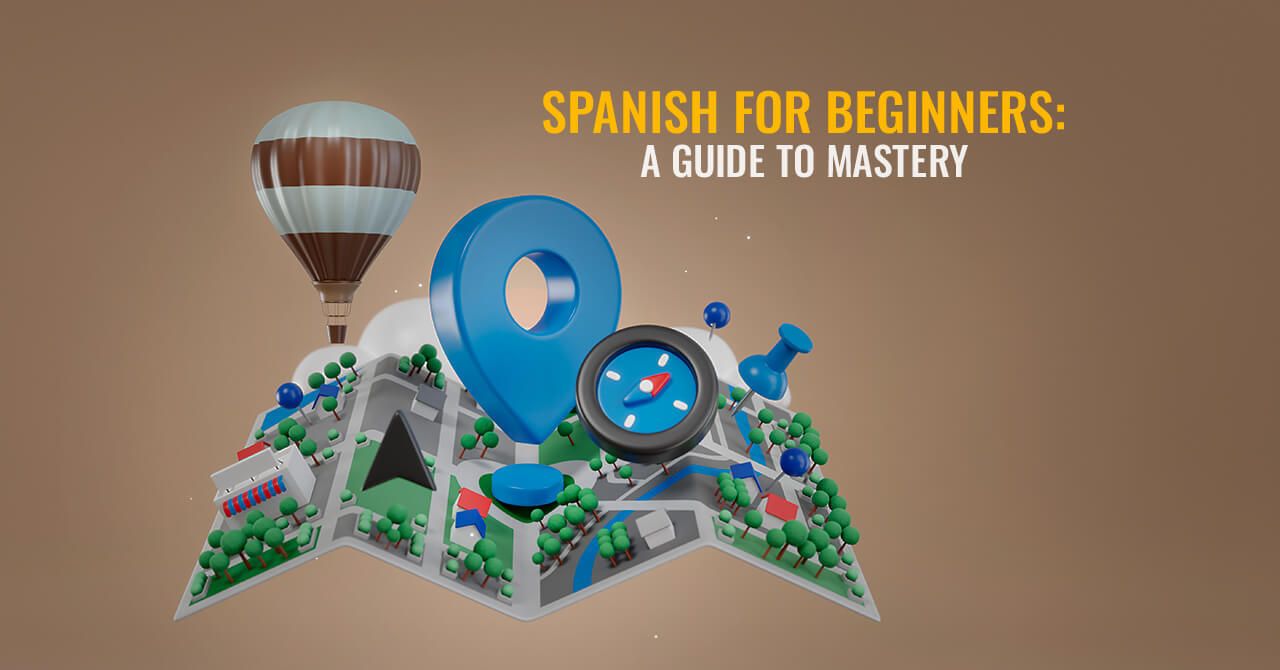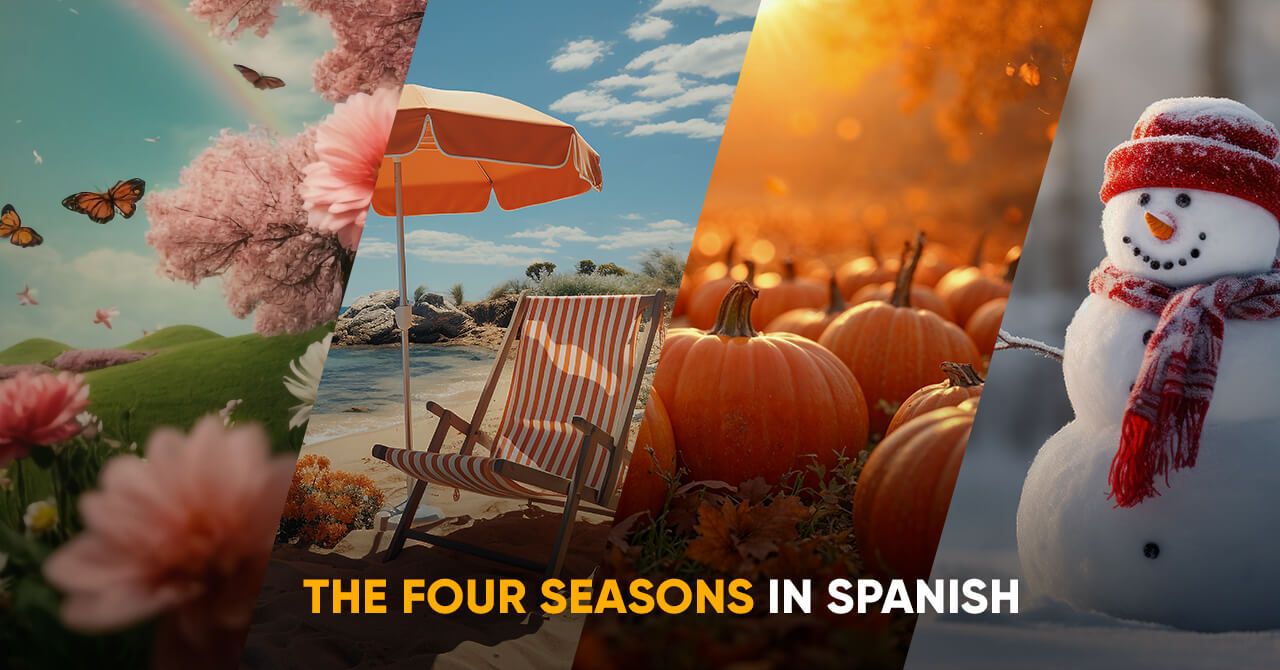
Seasons in Spanish | 4 Seasons, Weather Periods, And Their Months
Seasons in Spanish are, in appearance, the same as in English. We refer to them as periods, usually divided into fractions of 90 days. However, not all Spanish-speaking countries have the four seasons.
Essentially, seasons in Spanish and English are the same thing, correct? Sometimes. There are a few differences we must consider when addressing them. Many countries worldwide have four seasons; some others have only two.
Spanish has all kinds of words to describe them. Therefore, we will explain in detail how the seasons work in Spanish. Also, we will give you some tips and tools so you can learn this vocabulary easily.
What are the four seasons in Spanish?
Seasons in Spanish are, in appearance, the same as in English. We refer to them as periods, usually divided into fractions of 90 days. Normally, they come with changes in weather and visual modifications in the nature that surrounds us.
Not all Spanish-speaking countries have the four seasons. Quite the contrary. We only have four countries that have all seasons. Uruguay, Argentina, and Chile (in South America); Spain (in Europe). But, of course, there are also others like Peru or Mexico that, in certain regions, enjoy the climatic variation offered by the seasons.
It should also be noted that in 3 of these 4 countries, the periodicity of the seasons is inverted. This means that if we visit Argentina, Chile, and Uruguay in December, instead of finding snowy cities, we will have a summer of 36-40 degrees Celsius.
We will now go over each of them and explain at what times of the year they occur. We will also explain what vocabulary is related to each season and in which months they occur according to each region.
All the seasons in Spanish
Let us now review the names of the seasons and some vocabulary for each season.
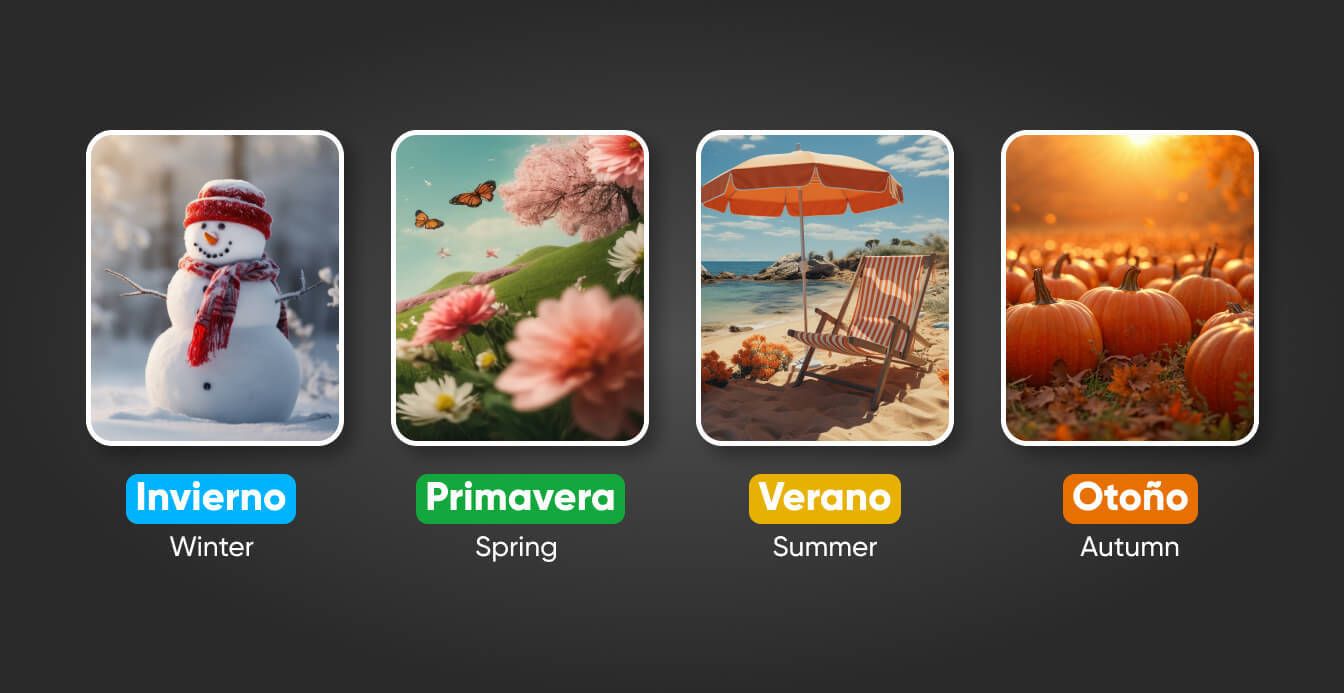
Winter season in Spanish
The word for winter in Spanish is “invierno.” It is the coldest period of the year. Normally, in the northern hemisphere, it occurs between Christmas and the beginning of the year. For some countries that have winter (except for Spain), it occurs in the middle of the year.

Some common words to describe winter in Spanish are:
- Frío – Cold
- Nieve – Snow
- Nevado – Snowy
- Hielo – Ice
- Guantes – Gloves
- Bufanda – Scarf
- Botas – Boots
- Chaqueta / Chamarra / Abrigo – Jacket
Winter months in Spanish
In the northern hemisphere, it begins in December and ends in February. The southern hemisphere starts in June and continues through August. Its months are pronounced as follows:
- Junio – June
- Julio – July
- Agosto – August
- Diciembre – December
- Enero – January
- Febrero – February
Spring season in Spanish
Spring season in Spanish is called “primavera.” It starts immediately after winter. It is a warmer season where vegetation flourishes and tends to have a more humid climate.
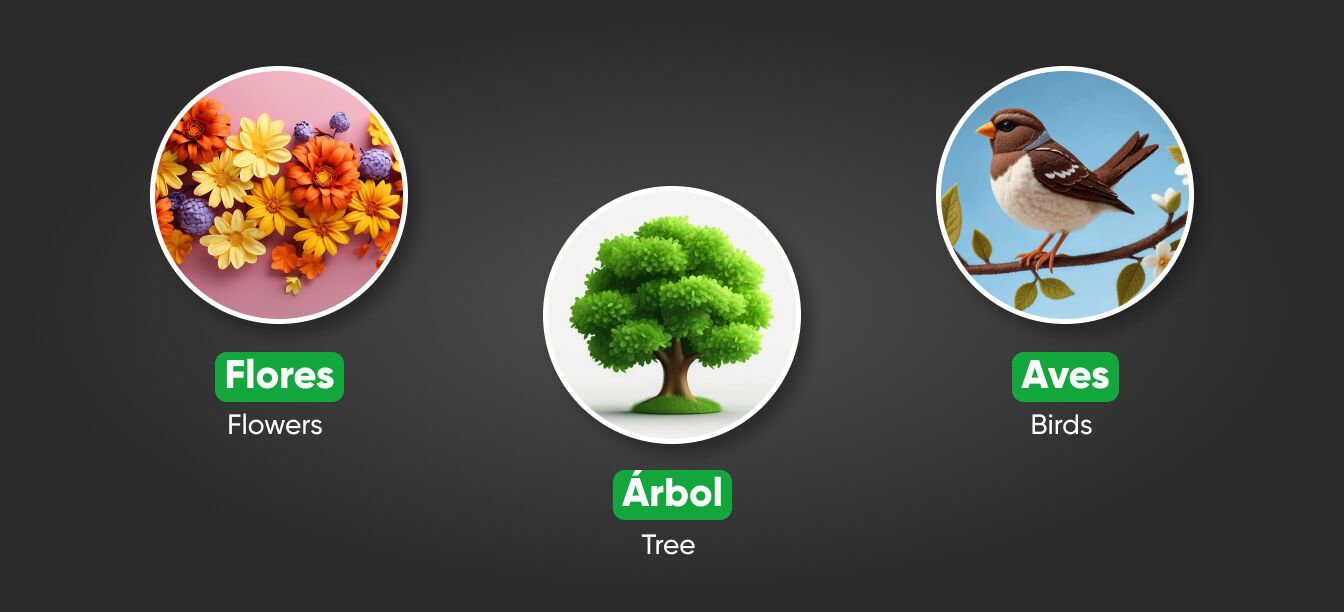
The most common vocalization related to this season is the following:
- Flores – Flowers
- Lluvia – Rain
- Humedad – Humidity
- Cesped / Pasto / Grama – Grass
- Verde – Green
- Árbol – Tree
- Aves – Birds
- Paseos – Walks
- Parques – Parks
Spring months in Spanish
For the northern hemisphere, it starts on March 21 until June 20. In the south, it begins on September 21 and ends on December 20. These months are:
- Marzo – March
- Abril – April
- Mayo – May
- Junio – June
- Septiembre – September
- Octubre – October
- Noviembre – November
- Diciembre – December
Summer season in Spanish
Summer in Spanish is “verano.” The summer months in Spanish, as in English, are the hottest. It is when schools go on holiday. Also, it is customary in many countries like Spain, Uruguay, and Argentina to plan vacations.
It is also very common for companies in the region to organize their holiday schedules. This is because many people travel in these seasons due to the heat. And, of course, the most common trips are to the beach.
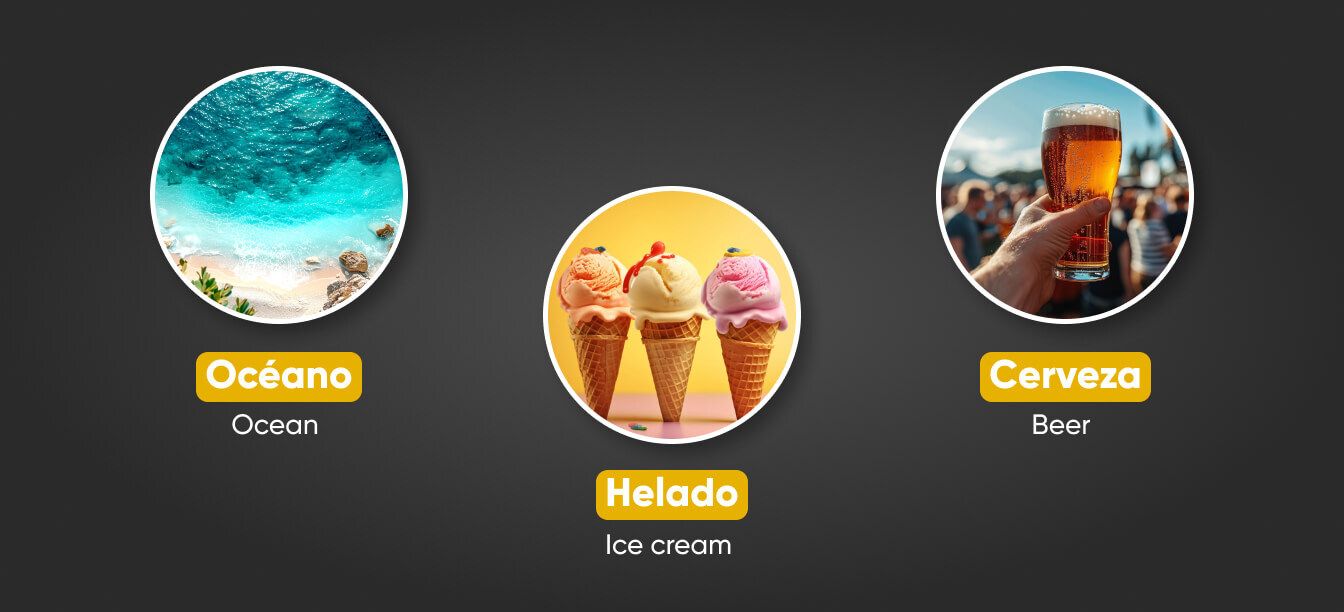
Among the vocabulary used for summer, we have:
- Sol – Sun
- Mar – Sea
- Océano – Ocean
- Viaje – Trip
- Viaje – Travel
- Playa – Beach
- Traje de baño – Swimming suit
- Broceado – Tan
- Helado – Ice cream
- Cerveza – Beer
- Vacaciones – Vacation
Summer months in Spanish
For those living in Central America, North America, the Caribbean, and Europe, it begins on June 21 and ends on September 20. In the south, it begins on December 21 and ends on March 20. The months in which summer occurs are:
- Junio – June
- Julio – July
- Agosto – August
- Septiembre – September
- Diciembre – December
- Enero – January
- Febrero – February
- Marzo – March
Autumn season in Spanish
Fall in Spanish season is called “otoño.” It is the season that follows summer. It is usually a slightly cooler season, with some cold breezes, warning that winter is approaching. Normally, in autumn, the leaves of the trees dry, and the vegetation changes to a more yellowish/reddish color.
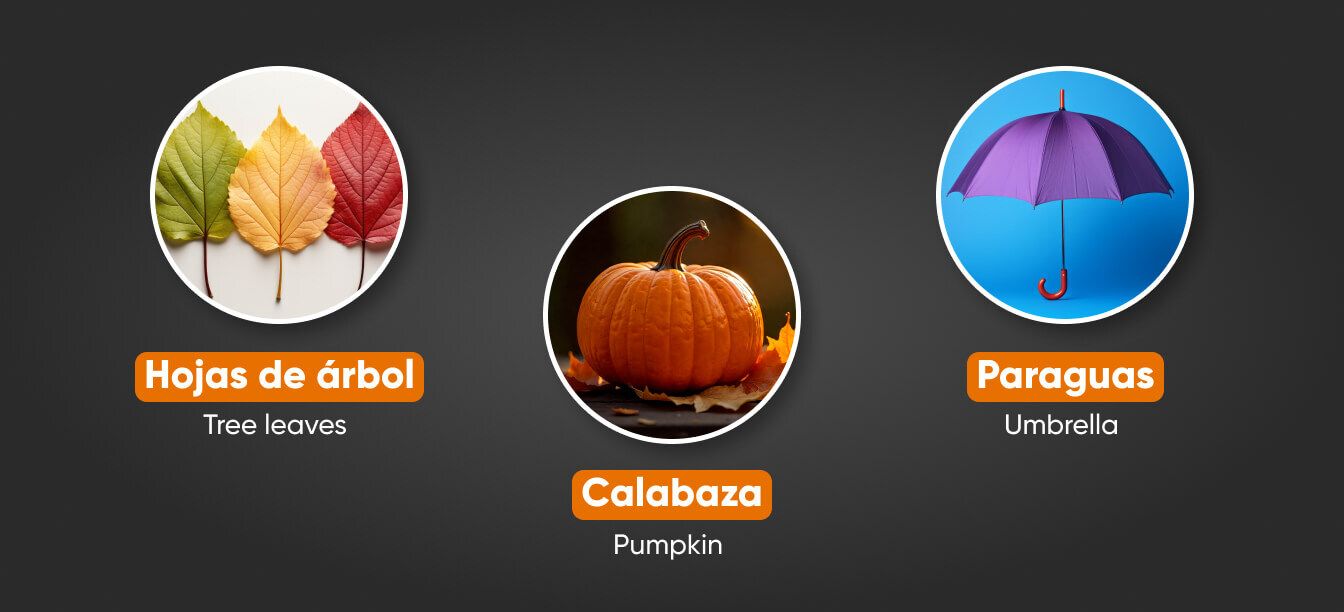
Some common fall words are as follows:
- Lluvia – Rain
- Hojas de árbol – Tree leaves
- Colorado – Colorful
- Viento – Wind
- Brisa – Breeze
- Calabaza – Pumpkin
- Paraguas – Umbrella
- Cosecha – Harvest
- Niebla – Fog
- Wood – Madera
- Acogedor – Cozy
Autumn months in Spanish
For months in seasons in Spanish for Autumn, we have the following: it begins on September 21 to December 20 for Central America, North America, the Caribbean, and Europe. March 21 to June 20 for South America. The months in which summer occurs are:
- Septiembre – September
- Octubre – October
- November – Noviembre
- Marzo – March
- Abril – April
- May – May
- Junio – June
Fun fact. In most countries in the northern hemisphere, autumn is associated with Halloween. However, this holiday is not traditional in Latin America or Spain. However, because of globalization, young people have gradually adopted this date as an excuse to celebrate. We, in South America, do not celebrate it in autumn. It is in spring.
Practice speaking Spanish on any topic fluently and stress-free. Click on the buttom below to get a free trial lesson with any tutor on LiveXP and start practicing.
Seasons of the year in Spanish: dry and rainy seasons
As previously mentioned, only 4 countries enjoy, practically in its entirety, the 4 seasons. As stated, these are Argentina, Chile, Uruguay, and Spain. All other countries only have 4 seasons in certain regions, or simply, they have another climatic reality.
So we don’t have seasons at all? Not exactly. Another phenomenon occurs in these countries. According to the change of axis of the hemispheres, there are two seasons, one of rain and one of drought. We simply call them “temporada de sequía” (dry season) and “temporada de lluvia” (rainy season).
For us, what would typically be spring and summer corresponds to the dry season, while autumn and winter align with the rainy season.
It is also important to clarify that these are not seasons; they are “temporadas” (periods). They are periods in which the scarcity or abundance of rain is present. Also, temperatures may vary somewhat.
The main characteristics of these seasons of the year in Spanish are the following:
- Temporada de sequía (dry season). It usually lasts an average of 6 months. The climate is more temperate and humid. There is usually a lot of rain. It is an excellent season for planting and working the land.
- Temporada de lluvia (rainy season). This is the opposite case. This is another 6 months when the climate is usually drier. It tends to be hot, and there is little rainfall.
How to remember all the seasons in Spanish
We know that this is a lot of vocabulary since the seasons are not only about the weather but also about events, activities, and dates.
So, to help you remember the seasons in Spanish easily, we recommend the following methods. These are tools and strategies that we have available from LiveXP:
- Word Trainer. It is an AI-powered feature in the LiveXP app that generates exercises based on the vocabulary we want to learn. Its operation is easy. Enter a word, and the tool will apply a spaced repetition method that generates possible exercises and content for the user. By practicing new words in the app, you will learn their pronunciation, spelling, and context.
- 1-on-1 sessions with tutors. At LiveXP, we have personalized teaching. You will find a catalog of native English teachers online from any country and be able to schedule a lesson with them. These lessons can be traditional classes in a virtual format or simple conversations on the topic you consider most convenient.
Vocabulary for the seasons in Spanish and English
There is much more vocabulary related to the seasons. They don’t have to do with the seasons per se but with elements such as weather, nature, and activities:
Nature:
- Brotes – Sprouting
- Polinización – Pollination
- Jardines – Gardens
- Pétalos – Petals
- Olas – Waves
- Arena – Sand
- Cielo despejado – Clear sky
- Cielo nublado – Cloudy sky
- Maíz – Corn
- Pinos – Pines
- Paisajes – Landscapes
Weather:
- Deshielo – Thaw
- Sol radiante – Radiant sunshine
- Días calidos – Warm days
- Días fríos – Cold days
- Días templados – Temperate days
- Calor – Heat
- Tardes calurosas – Hot afternoons
- Tardes frías – Cold afternoons
- Clima seco – Dry weather
- Clima húmedo – Humid weather
- Brisa fresca – Cool breeze
- Bajas temperaturas – Low temperatures
- Altas temperaturas – High temperatures
- Glanizo – Hail
Activities:
- Plantar – Planting
- Picnic – Picnic
- Jardinería – Gardening
- Senderismo – Hiking
- Buceo – Scuba Diving
- Nado / Natación – Swimming
- Acampado – Camping
- Fogatas – Campfires
- Rastrillar hojas – Raking leaves
- Esquí – Skiing
- Patinaje sobre hielo – Ice skating
- Hacer muñecos de nieve – Making snowmen
Events:
- Navidad – Christmas
- Halloween – Halloween
- Año Nuevo – New Year’s Day
- Equinoccio de primavera – Spring Equinox
- Equinoccio de otoño – Autumnal Equinox
- Solsticio de verano – Summer solstice
- Solsticio de invierno – Winter solstice
Regional station–related events in Latin America
It is also interesting to know that you will find certain kinds of festivities in different regions and countries. These holidays do not exist in countries outside of Latin America and are all related to the seasons:
- Fiesta de la Primavera y Juventud — Spring and Youth Festival (Mexico, Chile, Argentina, Uruguay, Perú). Celebrated in September (at the beginning of spring in the southern hemisphere). In countries such as Mexico, it coincides with Independence Day, and, in some countries, students and youth are also celebrated.
- Festival de las Flores — Flower Festival (Colombia) . Held in Medellin in August, this festival marks the arrival of spring in the northern hemisphere and is a traditional festival full of colorful flower parades and music.
- Inti Raymi (Peru, Ecuador, Bolivia). Celebrated on June 24, it coincides with the winter solstice in the southern hemisphere but marks the abundance of the sun, especially among Andean communities.
Ways to learn Spanish effectively
You can supplement your Spanish lessons and expand your Spanish vocabulary with traditional learning resources. We recommend:
- Review Spanish teaching manuals. It is a good idea to supplement your Spanish lessons with language manuals. They are especially useful because they are focused on grammar. They have exercises and grammar lessons. In addition, most of them include lessons on weather and seasons.
- Create worksheets and quizzes. A good way to learn, this time using memo tactic strategies, is with the help of flashcards. Create an index card for each season. Enter relevant information related to its characteristics, adjectives, and particularities.
- Try to speak Spanish. Take private lessons with Spanish teachers on LiveXP. You can choose tutors who share the same interests to have more engaged conversation lessons.
Conclusion
It is interesting to see how the Spanish seasons are different from English. Many English-speaking countries have four seasons. But, in the Spanish-speaking world, it doesn’t work the same way.
If you want to know more about the Spanish seasons of the year and learn the vocabulary you need, use one of our tools. At LiveXP, we provide users with different options for teaching Spanish, such as the Word Trainer or private lessons with tutors.
I'm from Argentina and I'm bilingual. I speak both English and Spanish as native languages. I'm a content writer with extensive experience.

